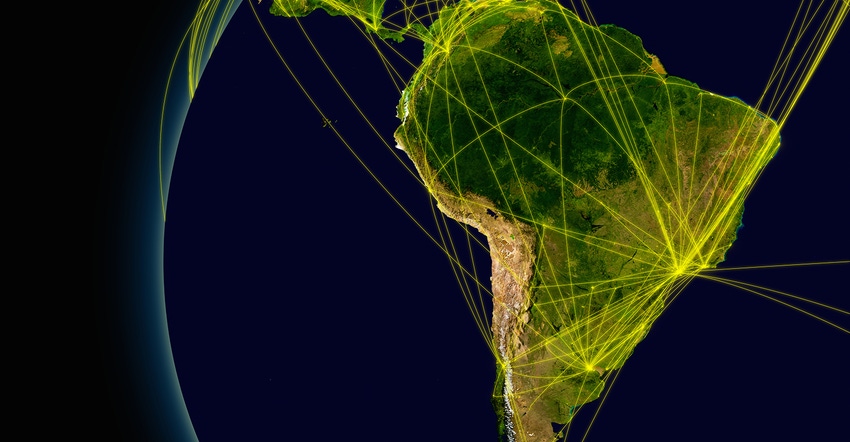Brazil and Argentina added to trade wars
Legislative Watch: Tariffs on Brazilian, Argentinian metals; beef exports to increase to EU; Japan approves pact; gov't payments, crop insurance boost farm income.

President Trump expanded the trade wars on Monday when he announced that immediately he was placing tariffs on steel and aluminum from Brazil and Argentina. In March of 2018, the administration exempted Brazil and Argentina from the tariffs. Earlier this year, the United States and Brazil met to begin preliminary discussions of a possible trade agreement in the future.
Also, the administration is proposing tariffs on $2.4 billion of French products in retaliation to France's digital services tax which impacts U.S. tech companies. The U.S. Trade Representative is accepting public comments and will hold a hearing on the proposed tariffs on Jan. 7.
A major question is where are we with the China negotiations? Trump earlier this week said he was in no hurry to end the trade war with China. He said he would be fine to wait until after the 2020 election to reach an agreement with China.
Later in the week he said the negotiations were going well. This is providing uncertainty in the market place and for producers as they get ready for next year. The talks are still continuing as we approach the Dec. 15 deadline of the United States putting 15% tariffs on an additional $165 billion of Chinese goods. The key issues are reduction in tariffs and the level of agricultural purchases.
More U.S. beef to EU
The EU Parliament approved the U.S.-EU Beef Access Agreement which will increase the amount of hormone-free beef exports to the EU. The agreement establishes a duty-free rate quota for the United States. The initial TRQ will be 18,500 mt annually ($220 million) and increase over seven years to 35,000 mt annually ($450 million).
The United States exports over 13,000 mt annually under the current agreement worth nearly $150 million which represents approximately 20% of the current quota according to the USTR. Australia, Uruguay and Argentina's share of the quota has been increasing over time. If a new agreement had not been reached the U.S. share of beef exports was expected to continue to decline.
Dan Halstrom, president of the U.S. Meat Export Federation says, "Approval by the European Parliament keeps this agreement on track for implementation in early 2020, which is outstanding news for the U.S. beef industry and our customers in Europe. Lack of capacity in the duty-free quota has been a source of frustration on both sides of the Atlantic, and a U.S.-specific share of the quota will help ensure that U.S. beef can enter the European market 52 weeks per year, without delay or interruption."
Next step is for the EU Council to approve the agreement with a possible implementation date of Jan. 1.
Japan approves trade agreement
The Japanese Diet on Wednesday ratified the U.S.-Japan Trade Agreement which was signed on Oct. 7 by the United States and Japan. Congress does not have to consider the agreement. It is planned to go into effect on Jan. 1.
This will be a major benefit to the pork and beef industries with the reduction of tariffs on U.S. pork and beef exports to Japan. The new tariffs will be the same as paid by the member countries of the Comprehensive and Progressive Agreement for Trans-Pacific Partnership and the European Union.
The U.S. Meat Export Federation estimates by 2025, U.S. beef exports to Japan will be approximately $2.8 billion and over $2 billion for U.S. pork.
According to the USMEF:
"Japan's tariffs on U.S. pork muscle cuts will be eliminated over nine years. Tariffs on most processed pork products, including the 20% tariff on ground seasoned pork, will be phased to zero over five years and for ham and bacon over 10 years. The maximum duty for product entering below the gate price will decline from 482 yen per kilogram to 125 yen upon implementation and to 50 yen per kilogram over nine years. Japan's World Trade Organization pork safeguard will no longer be applicable to U.S. pork, as Japan will create a new transitional safeguard mechanism for chilled and frozen pork similar to the one included in CPTPP."
Beef: "Japan's tariffs on U.S. chilled and frozen beef cuts are reduced from 38.5% to 9% over 15 years. Tariffs on beef tongues decline from 12.8% to zero by 2028 and for other offals by 2030. Tariffs on processed beef products are phased to zero in five to 15 years, depending on the product. U.S. chilled and frozen beef cuts will be subject to an annual U.S.-specific safeguard that begins at 242,000 metric tons and increases according to the schedule outlined in the USTR's beef fact sheet. A safeguard consultation mechanism unique to this agreement is also included."
Japan is the third largest market for U.S. agricultural exports importing $13 billion in 2018. It is a major market for U.S. corn, beef and beef products, pork and pork products, soybeans and wheat.
Government payments and crop insurance boost farm income
USDA's Economic Research Service is estimating net farm income to reach $92.5 billion in 2019, an increase of 10.2%. Direct government payments and crop insurance payments will account for 31% of the net farm income. Direct government payments (not including Federal Crop Insurance Corp. payments) are forecast to increase 64.0%.
Source: P. Scott Shearer, who is solely responsible for the information provided, and wholly owns the information. Informa Business Media and all its subsidiaries are not responsible for any of the content contained in this information asset.
About the Author(s)
You May Also Like



